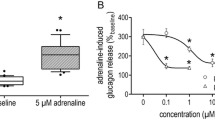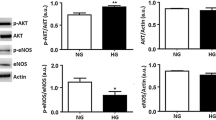Summary
Endothelin-1 (ET-1), a potent endothelium-derived vasoconstrictor peptide, is secreted in response to insulin. Elevated circulating ET-1 levels have been found in patients with diabetes mellitus and vascular dysfunction. The question arises whether ET-1 acts as a direct modulator of insulin secretion. To test this, we studied the effects of ET-1 on isolated mouse islets of Langerhans. ET-1 (1 nmol/l-1 Μmol/l) dose-dependently stimulated insulin secretion from islets incubated in the presence of 16.7 mmol/l glucose (p<0.05). The effect of ET-1 is glucose-dependent since no potentiation was found at 3.3 mmol/l glucose. Furthermore, ET-1 induced a large, transient increase in glucose-stimulated insulin secretion during islet perifusion in the presence (p<0.001), but not in the absence, of extracellular Ca2+. The rate of 45Ca2+-efflux from 45Ca2+-prelabelled islets was transiently stimulated by ET-1 during perifusion at 16.7 mmol/l glucose in the presence of extracellular Ca2+ (p<0.001). A short-lived increase in 45Ca2+-efflux was also observed in the absence of extracellular Ca2+ (p<0.05). It is suggested that the effects of ET-1 on insulin secretion are critically dependent on influx via Ca2+-channels. In addition, ET-1 transiently enhanced 86Rb+-efflux from 86Rb+-prelabelled islets both in the presence (p<0.001) and in the absence (p<0.001) of extracellular Ca2+ suggesting that ET-1 does not elicit insulin secretion by inhibition of the potassium permeability. Our study provides evidence that ET-1 stimulates insulin secretion via a direct effect on the islets of Langerhans.
Similar content being viewed by others
Abbreviations
- ET-1:
-
Endothelin-1
References
Yanagisawa M, Kurihara H, Kimura S et al. (1988) A novel potent vasoconstrictor peptide produced by vascular endothelial cells. Nature 332: 411–415
Yanagisawa M, Masaki T (1989) Molecular biology and biochemistry of the endothelins. Trends Pharmacol Sci 10: 374–378
Vierhapper H, Wagner O, Nowotny P, WaldhÄusl W (1990) Effect of endothelin-1 in man. Circulation 81: 1415–1418
Masaki T (1993) Endothelins: homeostatic and compensatory actions in the circulatory and endocrine systems. Endoer Rev 14: 256–268
Takahashi K, Ghatei MA, Lam HC, O'Halloran DJ, Bloom SR (1990) Elevated plasma endothelin in patients with diabetes mellitus. Diabetologia 33: 306–310
Haak T, Jungmann E, Felber A, Hillmann U, Usadel KH (1992) Increased plasma levels of endothelin in diabetic patients with hypertension. Am J Hypertens 5: 161–166
Fernandez-Cruz A, Patiño R, Ibarra J et al. (1994) Increased plasma endothelin in diabetes: an atherosclerosis marker. J Hypertens 12: S117 (Abstract)
Bertello P, Veglio F, Pinna G et al. (1994) Plasma endothelin in NIDDM patients with and without complications. Diabetes Care 17: 574–577
Maymind M, Zimmerman RS (1993) Somatostatin inhibits endothelin-1 induced insulin release. American Diabetes Association 547: 172A (Abstract)
Donckier JE, Hanet C, Berbinschi A et al. (1991) Cardiovascular and endocrine effects of endothelin-1 at pathophysiological and pharmacological plasma concentrations in conscious dogs. Circulation 84: 2374–2484
Lacy PE, Kostianovsky M (1967) Method for the isolation of intact islets of Langerhans from the rat pancreas. Diabetes 16: 35–39
Gregersen S, Langel ü, Bartfai T, Ahrén B (1993) N-terminally elongated fragments of galanin(l–16) inhibits insulin secretion from isolated mouse islets. Regul Pept 53: 31–37
Borle AB, Uchikawa T, Andersson JH (1982) Computer stimulation and interpretation of 45Ca2+ efflux profile patterns. J Membrane Biol 68: 37–46
Herquelz A, Malaisse WJ (1978) Regulation of calcium fluxes in pancreatic islets: dissociation between calcium and insulin release. J Physiol 283: 309–424
Henquin JC (1980) The potassium permeability of pancreatic islet cells: mechanisms of control and influence on insulin release. Hormone Metab Res 10: 66–73
Sehlin J, TÄljedal IB (1975) Glucose-induced decrease in Rb+ permeability in pancreatic B-cells. Nature 253: 635–636
Sparma OP, Flores JA, Leong DA, Veldhuis JD (1994) Mechanisms by which endothelin-1 stimulates increased cytosolic free calcium ion concentrations in single rat sertoli cells. Endocrinology 135: 127–134
Stojilkovic SS, Merelli F, Iida T, Krsmanovic LZ, Catt KJ (1990) Endothelin stimulation of cytosolic calcium and gonadotropin secretion in anterior pituitary cells. Science 248: 1663–1666
Stojilkovic SS, Catt KJ (1992) Neuroendocrine actions of endothelins. Trends Pharmacol Sci 13: 385–391
Prentki M, Matschinsky FM (1987) Ca2+, cAMP, and phospholipid-derived messengers in coupling mechanisms of insulin secretion. Physiol Rev 67: 1185–1248
Henquin JC, Debuyser A, Drews G, Plant TD (1992) Regulation of K+ permeability and membrane potential in insulin-secreting cells. In: Flatt PR (ed) Nutrient regulation of insulin secretion. Portland Press, London, pp 173–191
Fridolf T, Ahrén B (1991) GLP-1(7–36)amide stimulates insulin secretion in rat islets: studies on the mode of action. Diabetes Res 16: 185–191
Warnotte C, Gilon P, Nenquin M, Henquin JC (1994) Mechanisms of the stimulation of insulin release by saturated fatty acids. Diabetes 43: 703–771
Hu RM, Levin ER, Pedram A, Frank HJ (1993) Insulin stimulates production and secretion of endothelin from bovine endothelial cells. Diabetes 42: 351–358
Oliver FJ, Rubia G, Feener EP et al. (1991) Stimulation of endothelin-1 gene expression by insulin in endothelial cells. J Biol Chem 266: 23251–23256
Anfossi G, Cavalot F, Massucco P et al. (1993) Insulin influences immunoreactive endothelin release by human vascular smooth muscle cells. Metabolism 42: 1081–1083
Arai H, Hori S, Aramori I, Ohkubo H, Nakanishi S (1990) Cloning and expression of cDNA encoding an endothelin receptor. Nature 348: 730–732
Sakurai T, Yanagisawa M, Takuwa Y et al. (1990) Cloning of cDNA encoding a non-isopeptide selective subtype of the endothelin receptor. Nature 348: 732–735
Author information
Authors and Affiliations
Rights and permissions
About this article
Cite this article
Gregersen, S., Thomsen, J.L., Brock, B. et al. Endothelin-1 stimulates insulin secretion by direct action on the islets of Langerhans in mice. Diabetologia 39, 1030–1035 (1996). https://doi.org/10.1007/BF00400650
Received:
Revised:
Issue Date:
DOI: https://doi.org/10.1007/BF00400650




